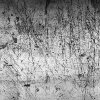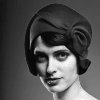Black and White Show
7 local artists, variety of black and white media
Behida Dolić, hats (behidadolic.com)
Helena Bianca, jewelry (helenabianca.com)
Rebecca Peters, linocut prints (rebpeterspress.com)
Natasha Dikareva, sculpture, etchings (dikarevart.com)
Irina Varshavsky, photographs
Peter Varshavsky, photographs
Peter Prato, photographs (peterprato.com)
Times:
September 24, Friday, opening 6-9pm
September 25, Saturday, 3-6pm
September 26, Sunday, closing 3-6pm
Free admission
2nd floor, no lift
953 Valencia Str (between 20th and 21st Sts), San Francisco
Behida Dolić was born in Bosnia and moved to the US after the Balkan wars of the 1990s with a 2-year stay in Florence, Italy. She graduated from the SF Art Institute and apprenticed with San Francisco milliner Deanna Gibbons. She has run a millinery business out of her home (currently in Berkeley) for 6 years. She hand drapes all her hats out of felt, and each is one of a kind. Behida draws inspiration from the elegance and simplicity of 1920s cloches, and the aesthetic of silent films, but also modern architecture the nature around her.
Helena Bianca studied painting and metalsmithing at the University of the Arts in Philadelphia as well as botany at Mills College in Oakland. With a foot in both fields, she looks to combine natural forms and scientific theories with her metal work. Her most recent body of work, CHAOS, is a study in harmonizing a random process with geometric shapes in order to create contained and wearable pieces with unpredictably textured surfaces. The CHAOS line is made using the unique ability of fine silver, 99.9% silver, to fuse to itself without solder. This process required both thought and intuition as the metal melts, slumps, and shifts in response to heat. The surface of each piece is unique and one of a kind.
Rebecca Peters makes linocut prints on her antique letterpress. Her artwork is inspired by the simple aesthetic of children’s books, where you seem to catch a glimpse of the middle of a story. She comes up with these images intuitively to create a scene that takes the viewer to a place where something odd, unexpected, or ridiculous is happening. These worlds are stripped free of politics, buildings, gadgets, etc., and get more to the heart of the matter. In general, her main goal is to make something that is meaningful and beautiful and to share a piece of her inner world.
Natasha Dikareva was raised in Kiev, Ukraine, an ancient city more than 1,500 years old, and she also lived in and studied art in St. Petersburg, Russia. Both places belong to a land eternally poised between East and West and endlessly alternating in the receipt of Eastern and Western influences. Cultural traditions of one historical era or another inspire her work. It seems that she creates her sculptures traveling freely through the history in search for links between the past and the present and the laws of universal harmony. In any of the cultures and times they represent, the images seem to emulate the genetic memory of mankind’s cultural experience. The theme of time, which is pivotal in her work, symbolizes the perpetual vitality of the world as manifested in the continuity of cultures rather than its transience.
Irina Varshavsky was born and lived most of her life in St. Petersburg, Russia. She worked with a microscope in medical diagnostic for many years. She still looks for the small details that make sense, but with the help of her camera lens. Irina studied photography and printmaking at Foothill College in Los Altos Hills. She prints both in darkroom and with desktop inkjet printer, respecting it is as an old time mechanical printing press. She also uses alternative photographic printing processes such as cyanotype.
Peter Varshavsky started studying photography during his last year as a math major at UCLA, where he worked as a staff photographer for Daily Bruin, the campus newspaper. He learned large format photography, darkroom and digital printing techniques from his mother Irina and spent about a year photographing friends and musicians in San Francisco until a shift of interest forced him to leave his camera at home in favor of dance shoes each night.
Peter Prato has worked with a variety of musicians and movement-based artists from throughout the Bay area. His photography has appeared in SPUR, The SF Chronicle, and The New York Times online. In addition to his freelance work he is the company photographer for the award-winning Bay Area theater group, Spare Stage. He received his first camera at the age of 9 from his mother, who remains his number one fan. He’s interested in the act of collaboration and in making people comfortable enough with having their picture taken that they don’t chase after him.







